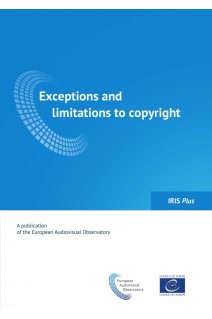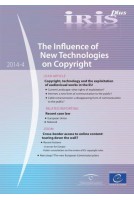- Exclusivité web !



Last September, Andrus Ansip, Vice-President for the Digital Single Market, talked about “transforming Europe's copyright rules in light of a new digital reality.” He outlined the multiple challenges concerning digital content thus: “Europe's creative content should not be locked-up, but it should also be highly protected, in particular to improve the remuneration possibilities for our creators”. The European Commission presented its new Copyright Package in September 2016 and the texts are currently being examined by the European Parliament and Council of Ministers.
To guide us through this complex process, the European Audiovisual Observatory, part of the Council of Europe in Strasbourg, has published its latest IRIS Plus report: Exceptions and limitations to copyright.
This is a truly invaluable roadmap through the often complex landscape of exceptions and limitations to copyright in Europe.
This IRIS Plus aims at providing a general overview of the rationale and the evolution of the exceptions and limitations to copyright (chapter 1) in the numerous international treaties and European directives devoted to this topic (chapter 2), and in the consequent ratifications and implementations at national level (chapter 3). Particular attention is given to the challenges deriving from the digital revolution, such as the adaptations of the rules concerning temporary acts of reproduction, private copying and exceptions for cultural heritage institutions to the online context.
Free download of PDF version on Observatory’s website
1. Setting the scene
1.1. The origins of copyright
1.1.1. From Gutenberg’s press to the Statute of Anne
1.1.2. Beaumarchais’ first supper
1.2. An exceptional property right
1.3. The economic impact of certain exceptions and limitations to copyright in the European Union
1.3.1. The access to film heritage works in the digital era
1.3.2. Private copying
2. International and European legal framework
2.1. Exceptions and limitations at international level
2.1.1. The Berne Convention
2.1.2. Extension of the scope of the three-step test under the TRIPS Agreement
2.1.3. Exceptions and limitations in the digital age: the WIPO Internet Treaties
2.1.4. New mandatory exceptions for blind and visually-impaired persons under the Marrakesh Treaty
2.2. Exceptions to copyright and related rights in the EU acquis
2.2.1. General overview
2.2.2. Main exceptions related to the digital environment
3. National legal framework
3.1. General overview
3.2. Overview of national implementations of certain exceptions to copyright
3.2.1. Exception for temporary acts of reproduction (transient copies)
3.2.2. Exception for reproductions for private uses (private copying)
3.2.3. Exception for cultural heritage institutions
3.2.4. Exceptions for reporting of current events, quotations for criticism or review and parodies
4. The role of self and co-regulation
4.1. General overview of EU strategies
4.2. Memorandum of Understanding on Out-of-Commerce Works
4.3. Access to copyright works for people with print disabilities
4.4. Licenses for Europe
4.4.1. Facilitating the digitisation and access to audiovisual heritage
4.4.2. Text and data mining for research purposes
4.5. “Open” copyright licenses initiatives
4.5.1. Free and open-source software domain and “copyleft” licenses
4.5.2. “Creative Commons” (CC) licenses
5. Case law
5.1. General principles
5.2. Caricature, parody or pastiche
5.3. Private copying
5.3.1. Padawan v. SGAE
5.3.2. EGEDA et al. v Administración del Estado et al.
5.3.3. ACI Adam v Stichting de Thuiskopie
6. State of play
6.1. Copyright exceptions in the bigger picture of the DSM
6.2. Policy documents concerning exceptions and limitations
6.2.1. From the Green Paper to the Vitorino Recommendations
6.2.2. The actions under the DSM strategy
6.3. The “copyright package”
6.3.1. The rationale underlying the four new mandatory exceptions
6.3.2. Text and data mining in the field of scientific research
6.3.3. Digital and cross-border uses in the field of education
6.3.4. Preservation of cultural heritage
6.3.5. Accessible formats for people with disabilities
6.4. The pending issues
6.4.1. The e-lending exception
6.4.2. The panorama exception
6.4.3. The private copying exception
6.5. The state of the legislative process
Figures
Figure 1. Copyright exceptions in the EU-28
Figure 2. The “panorama exception” worldwide
Tables
Table 1. Overview of limitations and exceptions under the Berne Convention
Table 2. Tariff-setting models
Table 3. Overview of countries that apply a percentage as a tariff
Table 4. Conditions for Creative Commons licenses
Table 5. Jurisprudence from the European Court of Justice concerning private copying
Table 6. The three pillars of the Digital Single Market (with programmed years of proposal)
Table 7. Overview of tools and objectives of the “copyright package”
Table 8. Compensation regimes for publishers in EU-28



Last September, Andrus Ansip, Vice-President for the Digital Single Market, talked about “transforming Europe's copyright rules in light of a new digital reality.” He outlined the multiple challenges concerning digital content thus: “Europe's creative content should not be locked-up, but it should also be highly protected, in particular to improve the remuneration possibilities for our creators”. The European Commission presented its new Copyright Package in September 2016 and the texts are currently being examined by the European Parliament and Council of Ministers.
To guide us through this complex process, the European Audiovisual Observatory, part of the Council of Europe in Strasbourg, has published its latest IRIS Plus report: Exceptions and limitations to copyright.
This is a truly invaluable roadmap through the often complex landscape of exceptions and limitations to copyright in Europe.
This IRIS Plus aims at providing a general overview of the rationale and the evolution of the exceptions and limitations to copyright (chapter 1) in the numerous international treaties and European directives devoted to this topic (chapter 2), and in the consequent ratifications and implementations at national level (chapter 3). Particular attention is given to the challenges deriving from the digital revolution, such as the adaptations of the rules concerning temporary acts of reproduction, private copying and exceptions for cultural heritage institutions to the online context.
Free download of PDF version on Observatory’s website
Attention, en vertu de nos conditions générales de vente, l'achat des PDF/epub est réservé aux particuliers.
